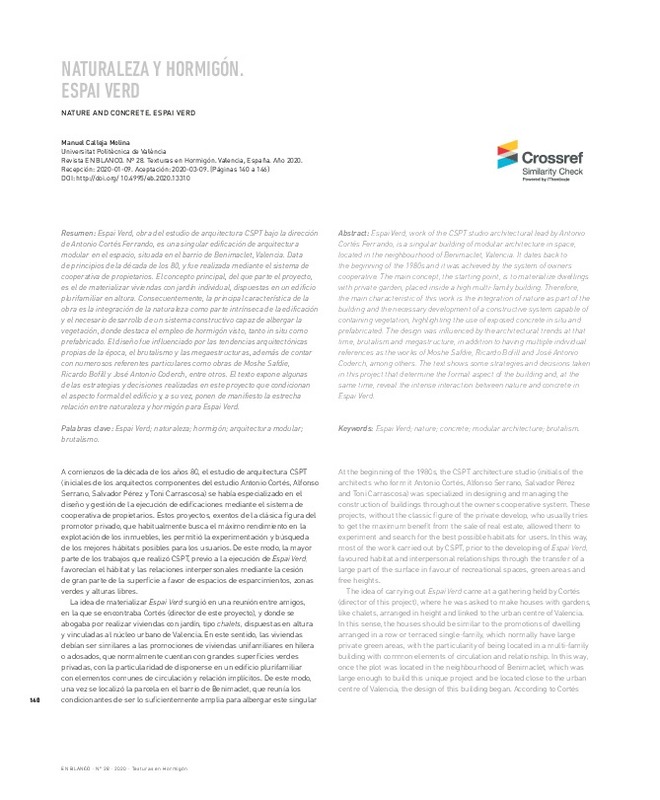|
Resumen:
|
[EN] Espai Verd, work of the CSPT studio architectural lead by Antonio Cortés Ferrando, is a singular building of modular architecture in space, located in the neighbourhood of Benimaclet, Valencia. It dates back to the ...[+]
[EN] Espai Verd, work of the CSPT studio architectural lead by Antonio Cortés Ferrando, is a singular building of modular architecture in space, located in the neighbourhood of Benimaclet, Valencia. It dates back to the beginning of the 1970s and it was achieved by the system of owners cooperative. The main concept, the starting point, is to materialize dwellings with private garden, placed inside a high multi-family building. Therefore, the main characteristic of this work is the integration of nature as part of the building and the necessary development of a constructive system capable of containing vegetation, highlighting the use of exposed concrete in situ and prefabricated. The design was influenced by the architectural trends at that time, brutalism and megastructure, in addition to having multiple individual references as the works of Moshe Safdie, Ricardo Bofill and José Antonio Coderch, among others. The text shows some strategies and decisions taken in this project that determine the formal aspect of the building and, at the same time, reveal the intense interaction between nature and concrete in Espai Verd.
[-]
[ES] Espai Verd, obra del estudio de arquitectura CSPT bajo la dirección de Antonio Cortés Ferrando, es una singular edificación de arquitectura modular en el espacio, situada en el barrio de Benimaclet, Valencia. Data de ...[+]
[ES] Espai Verd, obra del estudio de arquitectura CSPT bajo la dirección de Antonio Cortés Ferrando, es una singular edificación de arquitectura modular en el espacio, situada en el barrio de Benimaclet, Valencia. Data de principios de la década de los 80, y fue realizada mediante el sistema de cooperativa de propietarios. El concepto principal, del que parte el proyecto, es el de materializar viviendas con jardín individual, dispuestas en un edificio plurifamiliar en altura. Consecuentemente, la principal característica de la obra es la integración de la naturaleza como parte intrínseca de la edificación y el necesario desarrollo de un sistema constructivo capaz de albergar la vegetación, donde destaca el empleo de hormigón visto, tanto in situ como prefabricado. El diseño fue influenciado por las tendencias arquitectónicas propias de la época, el brutalismo y las megaestructuras, además de contar con numerosos referentes particulares como obras de Moshe Safdie, Ricardo Bofill y José Antonio Coderch, entre otros. El texto expone algunas de las estrategias y decisiones realizadas en este proyecto que condicionan el aspecto formal del edificio y, a su vez, ponen de manifiesto la estrecha relación entre naturaleza y hormigón para Espai Verd.
[-]
|








